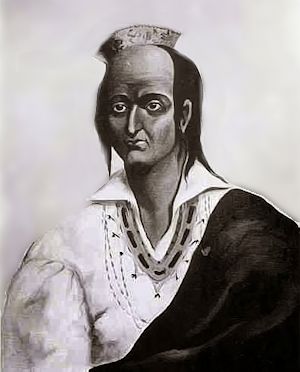Metacomet was better known to whites as King Philip. He was also known as Metacom or Philip of Pokanoket. He was the second son of the sachem Massasoit, and became a chief of his people in 1662 when his brother Wamsutta (or King Alexander) died shortly after their father Massasoit.
(born c. 1638, Massachusetts—died August 12, 1676)
 Wamsutta’s widow Weetamoo , sunksqua of the Pocasset, was Metacomet’s ally and friend for the rest of her life. Metacomet married Weetamoo’s younger sister Wootonekanuske. No one knows how many children they had or what happened to them all. Wootonekanuske and one of their sons were sold to slavery in the West Indies following the defeat of the Native Americans in what became known as King Philip’s War.
Wamsutta’s widow Weetamoo , sunksqua of the Pocasset, was Metacomet’s ally and friend for the rest of her life. Metacomet married Weetamoo’s younger sister Wootonekanuske. No one knows how many children they had or what happened to them all. Wootonekanuske and one of their sons were sold to slavery in the West Indies following the defeat of the Native Americans in what became known as King Philip’s War.
King Philip’s people occupied a territory that bordered on present day Boston to the north, extending west to Warren, Rhode Island, and south and east to the coast of Cape Cod, including Martha’s Vineyard (Noepe) and Nantucket Islands. It is recorded that he bought his clothes in Boston.
In the spring of 1660 Metacomet’s brother Wamsutta appeared before the court of Plymouth to request that he and his brother be given English names. The court agreed and Wamsutta had his name changed to Alexander, and Metacomet’s was changed to Philip. Metacomet was later called “King Philip” by the English.
King Phillip’s War
Metacomet used tribal alliances to coordinate efforts to push European colonists out of New England. Many of the native tribes in the region wanted to push out the colonists following conflicts over land use, diminished game as a consequence of expanding European settlement, and other tensions.
For 13 years Metacomet’s leadership kept the region’s towns and villages on edge with the fear of an Indian uprising. Finally, in June 1675, violence erupted when three Wampanoag warriors were executed by Plymouth authorities for the murder of John Sassamon, a tribal informer.
Metacom’s allies, including the Wampanoag, Narraganset, Abenaki, Nipmuc, and Mohawk, were at first victorious. They attacked over half of New England’s ninety-two towns. However, after fourteen months of savage fighting during which some 3,000 Indians and 600 colonists were killed, and 12 frontier towns were destroyed, food became scarce, and the indigenous alliance began to disintegrate.
Seeing that defeat was imminent, Metacom returned to his ancestral home at Mount Hope. As the colonists brought their growing numbers to bear, King Philip and some of his followers took refuge in the great Assowamset Swamp in southern Massachusetts. He held out for a time, with his family and remaining followers, but was eventually betrayed by an Indian informant.
Hunted by a group of rangers led by Captain Benjamin Church, he was fatally shot by an Indian named John Alderman, on August 12, 1676, in the Miery Swamp near Mount Hope in Bristol, Rhode Island. After his death, his wife and nine-year-old son were captured and sold as slaves in Bermuda, along with others who surrendered. Some of his supporters escaped to Canada.
Philip’s head was mounted on a pike at the entrance to Fort Plymouth, where it remained for more than two decades. His body was cut into quarters and hung in trees. Alderman was given Metacomet’s right hand as a reward. The fighting ended shortly after Metacom was captured and beheaded.
The remnants of Metacomet’s tribe are known today as the Wampanoag Tribe of Gay Head.

